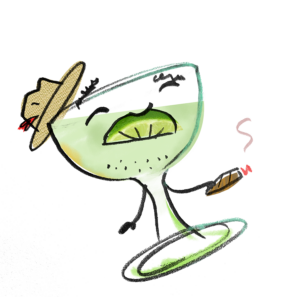 DAIQUIRI
DAIQUIRI
Santiago | 1890
3/4 oz simple syrup
1 oz lime juice
2 oz light Cuban-style or blended rum
Garnish: lime wheel
Recommended spirits: Havana Club 3,
Banks 5 Island, Plantation 3 Stars, Plantation Stiggins’ Fancy
The Daiquiri was standardized by Jennings Cox, an American mining engineer working in Santiago, Cuba around 1896. But mixing rum with citrus and sugar was nothing new to the Caribbean, nor to Colonial Americans who hovered around the communal punch bowl, nor to British sailors who were issued daily rations of rum, limes, sugar, and water as “grog” as far back as 1740. But where those naval grogs were primarily thin via dilution with ample water, the sour style went straight to the point with a little single-serving flavor bomb. In its beginning, a Sour was any spirit with lemon and sugar — and not overwhelmingly tart, as the name might suggest. Cocktail historian David Wondrich has uncovered an 1856 menu from Mart Ackermann’s Saloon in Toronto, Canada, that lists a Gin Sour and a Brandy Sour. In his pioneering 1862 book, How to Mix Drinks, or the Bon Vivant’s Companion, Jerry Thomas includes the Gin Sour and Brandy Sour as members of a family of drinks, along with their antecedents: punches, crustas, and daisies. A recipe for a Rum Sour appears in the 1895 cocktail book The Mixicologist. Shaking the old rum, lime, and sugar formula with ice may have been the official crowning of the Daiquiri as we know it, sometime in the late 19th century. Eventually, the drink fell into popular misuse as an overly-sweet frozen slushy and shorthand (at least in New Orleans) for a stomach-churning array of unrelated frozen drinks with grain alcohol and artificial flavors. Cocktail enthusiasts have come to appreciate it as a bit of a “secret shopper” test that determines a bartender’s skills and knowledge. When it’s done properly, with fresh limes and their fragrant oil, there’s simply nothing like a Daiquiri.


 COUPE
COUPE